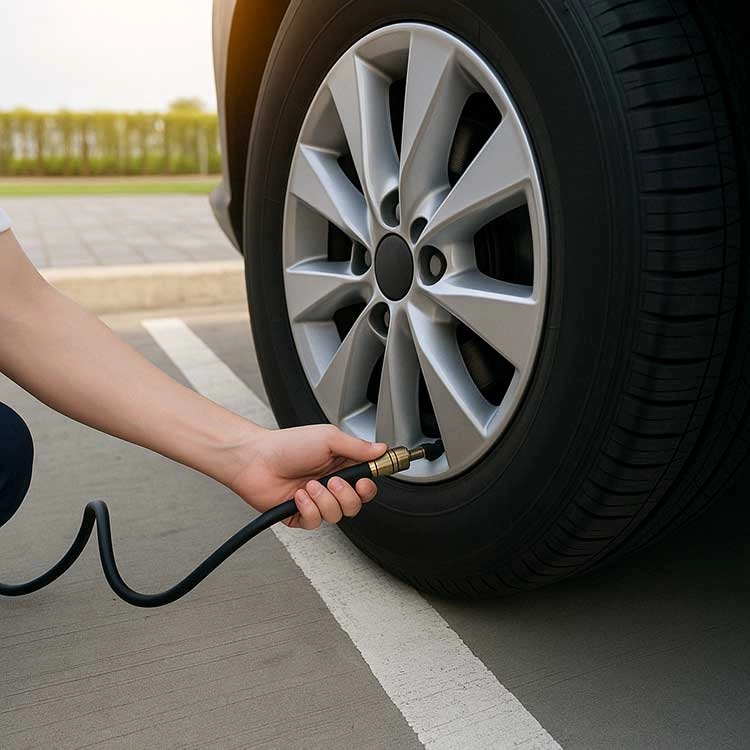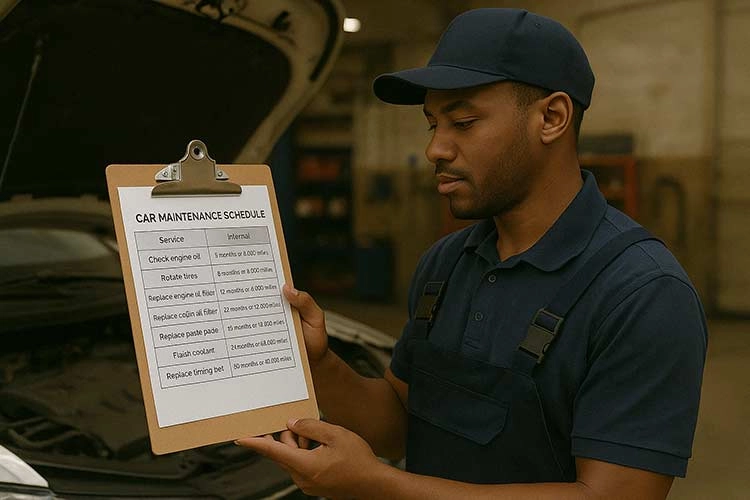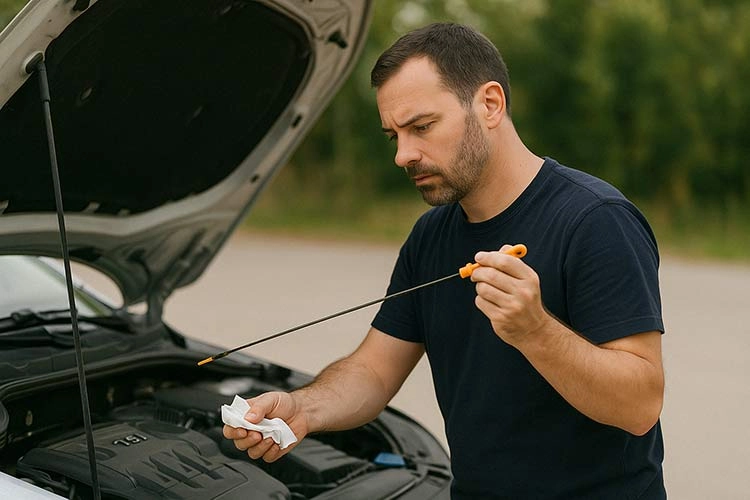
Best Tire Pressure for Fuel Economy – TPMS Light & Gas Mileage Guide
Are you aware that something simple as under-inflated tires can reduce your fuel consumption/ gas mileages by up to 3%? Which leads to paying more for fuel simply because your tires aren't at their optimal pressure. The tire pressure is often overlooked, but it is one of the easiest way to improve your car performance and same money on gas.
Under inflated tires significantly increase rolling resistance of the wheels, which eventually leads the engine to work harder. Some studies indicated that 10% under inflated tires can lead to 2% increate in fuel consumption, while 20% under inflated tires can increase as much as 4%
Speed also has an impact under-inflation varies with speed. At lower speeds (e.g., 40 mph), having tires at 50% of their recommended pressure can reduce fuel economy by about 10%, but this penalty decreases to around 5% at higher speeds (80 mph)
In order to improve your fuel consumption by 0.6% on average up - 3% simply by keeping your tires inflated to the proper pressure. You can view it from this point of view, less air in the tire lead more tire mass in contact to the ground. So, every psi drop in there is 0.2% more fuel needed to move the tire.
| Tire Pressure Condition | Fuel Economy Impact |
|---|---|
| Recommended Pressure | Up to 3% improvement |
| 10% Under-Inflation | ~2% increase in fuel consumption |
| 20% Under-Inflation | ~4% increase in fuel consumption |
| Every 1 PSI drop | ~0.2% decrease in fuel economy |
Maintaining proper tire pressure not only enhances fuel efficiency but also improves vehicle safety and prolongs tire life. Regularly checking and adjusting tire pressure is a simple yet effective way to optimize vehicle performance and reduce fuel costs.
What is the Best Tire Pressure for Fuel Economy?
The best tire pressure for optimal fuel consumption is typically the manufacturer's recommended pressure, which can be found on the sticker inside the driver's door or in the owner's manual. The manufacturer designs the pressure to be perfectly balanced for safety, performance, and fuel efficiency.
The Importance of Manufacturer Recommendations: While 32-35 psi is a good general range, the ideal tire pressure for your vehicle may differ. This is because vehicle manufacturers design each model with specific tire pressures in mind, considering factors such as vehicle weight, balance, and handling. Using the manufacturer-recommended tire pressure helps ensure that your car runs efficiently and safely. The recommended tire pressure can typically be found:
- On a sticker located inside the driver’s door frame
- Inside the vehicle’s owner’s manual
- Occasionally, on the fuel door or glove compartment
Following these guidelines not only supports fuel economy but also helps maintain proper tire wear and enhances handling. It’s important to remember that both under-inflation and over-inflation can negatively affect your vehicle’s performance.
How to Check Your Tire Pressure
With just a few simple tools and steps, you can ensure your tires are properly inflated and your vehicle is operating at peak efficiency. Checking your tire pressure regularly—at least once a month—is ideal for staying on top of any air loss that could impact fuel economy and handling.
What You’ll Need: To check your tire pressure, you’ll need a tire pressure gauge. These gauges come in various types, including:
- Digital Gauges: Easy to read and accurate, with a digital display.
- Dial Gauges: Traditional gauges with an analog display.
- Pencil-Style Gauges: Compact and affordable, though sometimes less accurate than digital models.
You can find tire pressure gauges at auto parts stores, big-box stores, and online. Additionally, most gas stations have air pumps with built-in gauges, though their accuracy may vary.
Step-by-Step Guide to Checking Tire Pressure:
- Start with Cold Tires: Tire pressure can fluctuate with temperature, so it’s best to check your tires when they’re cold. This means waiting at least three hours after driving, or checking first thing in the morning before the day warms up.
2. Locate the Recommended Tire Pressure: Before checking the pressure, make sure you know the recommended psi for your vehicle. This information is usually found on a sticker inside the driver’s door frame, in the vehicle’s manual, or sometimes on the fuel door. The recommended pressure ensures you’re getting the best tire pressure for fuel efficiency, safety, and comfort.
3. Remove the Valve Cap: Unscrew the cap from the tire’s valve stem, a small rubber or metal tube sticking out from the tire. Set the cap aside where it won’t get lost.
4. Press the Tire Gauge onto the Valve Stem: Place the tire gauge firmly onto the valve stem, pressing down until you hear a short hiss and the gauge registers the tire pressure. If you continue to hear a hissing sound, adjust the gauge until it fits snugly on the valve stem to get an accurate reading.
5. Read the Pressure: Look at the gauge’s reading to see your tire’s current pressure. Compare it to the manufacturer’s recommended psi. If the pressure is too low, you’ll need to add air; if it’s too high, you can release some by pressing on the valve stem (most gauges have a small button for releasing air).
6. Adjust the Pressure as Needed:
- To Add Air: Use an air compressor, found at most gas stations. Press the air hose nozzle onto the valve stem and fill until the gauge shows the correct pressure. Check the gauge frequently to avoid over-inflation.
- To Release Air: Use the gauge or a small tool to press on the valve stem and let air out in small bursts. Recheck the pressure until you reach the recommended level.
7. Replace the Valve Cap: After adjusting the pressure, screw the cap back onto the valve stem. This helps protect the valve from dirt and debris.
Best Practices for Tire Pressure Maintenance:
Check When Tires Are Cold: Always check tire pressure when tires are cold for the most accurate reading.
Monitor Seasonal Changes: As the temperature drops, so can your tire pressure. For every 10°F drop, tire pressure can decrease by about 1 psi, so it’s crucial to check pressure more often in colder months.
Don’t Forget the Spare Tire: Regularly check the spare tire’s pressure as well, so you’ll have a properly inflated spare ready if needed.
By following these simple steps and best practices, you can ensure that your tires are always at the best tire pressure, improving fuel economy, enhancing handling, and extending the life of your tires. Remember, consistent tire maintenance is one of the easiest ways to keep your vehicle running safely and efficiently!
The Impact of Over-Inflation and Under-Inflation
Maintaining the correct tire pressure is important not only for fuel efficiency, but also for safety and balanced tire wear. Both over-inflation and under-inflation can negatively impact the performance of your vehicle and result in added expenses, from increased fuel consumption to premature tire wear and potential safety hazards
The Dangers of Under-Inflated Tires
Decreased Traction: Low pressure reduces the tire’s grip on the road, particularly in wet conditions, increasing the likelihood of hydroplaning.
Excessive Heat Buildup: The increased friction caused by under-inflation generates excess heat, which can weaken the tire’s structure and lead to blowouts.
Uneven and Rapid Wear: Under-inflated tires tend to wear out on the edges faster than in the center, shortening their overall lifespan and requiring more frequent replacements.
The Dangers of Over-Inflated Tires
Reduced Traction and Comfort: Over-inflated tires provide a rougher ride, as they don’t absorb road irregularities as well. This can lead to less comfortable driving conditions and reduced traction, especially on rough or uneven surfaces.
Increased Risk of Tire Damage: Because over-inflated tires are more rigid, they are more susceptible to damage from road hazards such as potholes or debris. Hitting an obstacle with over-inflated tires can increase the risk of punctures or blowouts.
Uneven Wear Patterns: Over-inflated tires wear down the center tread more quickly than the edges, leading to shorter tire life and the need for more frequent replacements.
FAQs
1. What is the recommended tire pressure for my car? Check the sticker inside the driver’s door or the owner’s manual for the manufacturer’s recommended tire pressure, typically between 32-35 psi for most cars.
2. Does tire pressure really affect gas mileage? Yes, under-inflated tires increase rolling resistance, reducing gas mileage by up to 3%.
3. How often should I check my tire pressure? Check your tire pressure at least once a month, and before long trips.
4. What happens if my tire pressure is too high or too low? Too low, and you’ll reduce fuel efficiency and increase tire wear; too high, and you’ll reduce traction and increase the risk of tire damage.
5. Can tire pressure monitoring systems (TPMS) replace manual checks? No, TPMS only alerts you when pressure is significantly low. Regular manual checks are still essential for accuracy and optimal performance.

